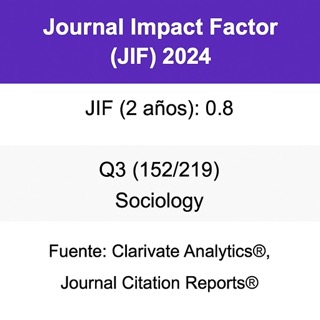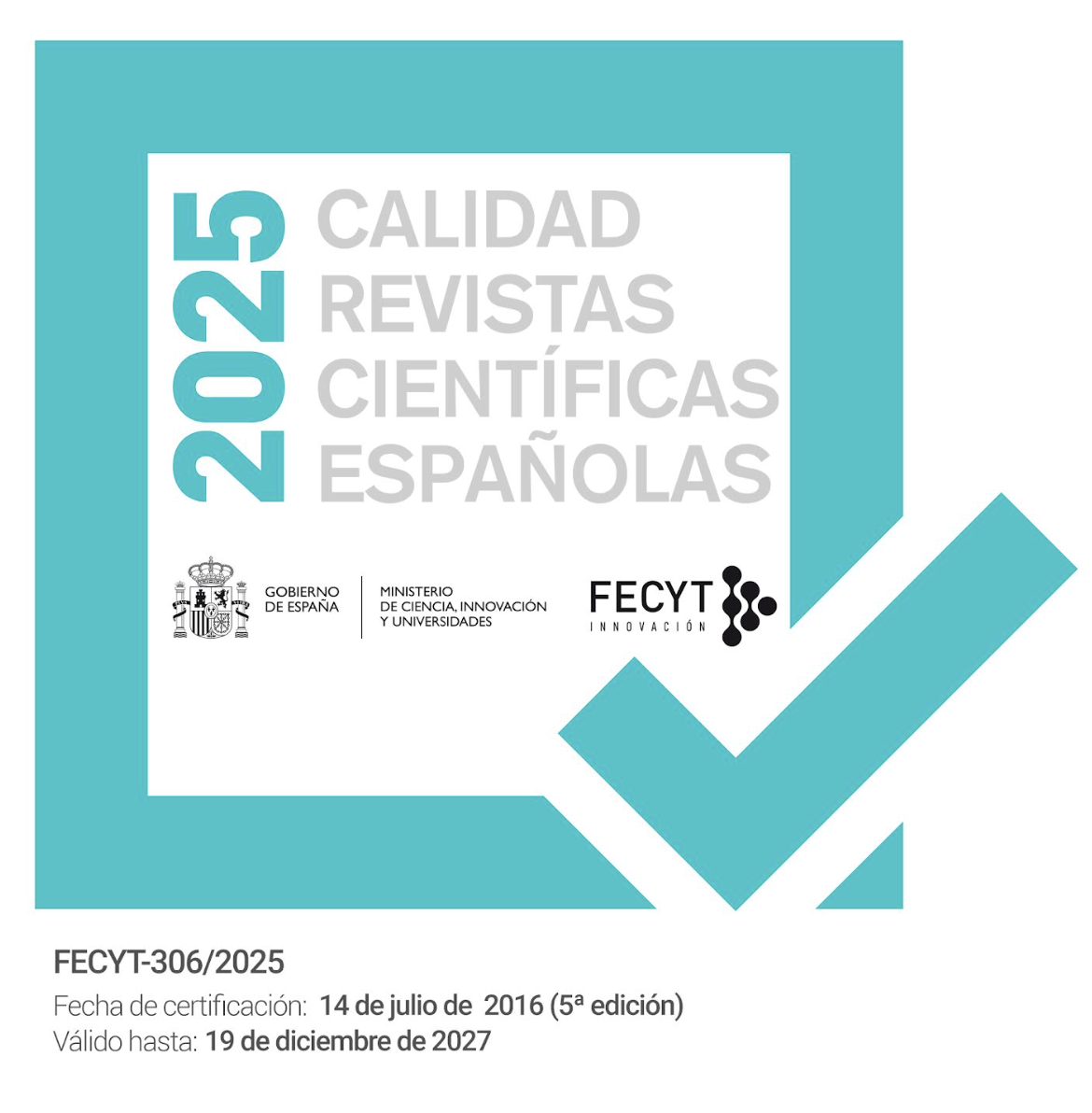¿Importa la edad? El bienestar de los niños migrantes desde una perspectiva comparada
DOI:
https://doi.org/10.22325/fes/res.2024.214Palabras clave:
aceptación, agencia, bienestar, diferencias de edad, niños migrantesResumen
Este artículo explora las percepciones subjetivas del bienestar de los niños inmigrantes que asisten a la escuela primaria (9-14 años) y secundaria (15-18 años) en Eslovenia. Se centra en cómo conceptualizan sus miedos, preocupaciones e inquietudes, qué es importante para ellos para sentirse aceptados y seguros, y cómo piensan sobre su pasado y su futuro. Utilizando una perspectiva comparativa, se exploran las similitudes y diferencias en la experiencia de bienestar de estos dos grupos de edad de emigrantes. El análisis se basa en entrevistas narrativas abiertas con niños migrantes, analizando si la edad influye en su percepción subjetiva del bienestar y cómo lo hace. El artículo esclarece los significados y la comprensión de los procesos migratorios específicos de cada edad, basándose en las opiniones y experiencias de los niños y jóvenes migrantes respecto a su bienestar, poniendo en primer plano las perspectivas de los niños que suelen estar ausentes o subrepresentados en el diseño de políticas de integración.
Citas
Abdul-Rida, C., & Nauck, B. (2014). Migration and child well-being. In: Ben-Aryeh, A., Casas, F., Frønes, I., & Korbin, J. E. (Eds.) (2014). Handbook of child well-being: Theories, methods and policies in global perspective (pp. 1-27). Springer.
Arun, S., Bailey, G., & Szymczyk, A. (2021). Child migrants ‘integrating’: What do we know so far?. In Migrant Children’s Integration and Education in Europe: Approaches, Methodologies and Policies (pp. 39-59). Ediciones Octaedro SL.
Bajo Marcos, E., Serrano, I., & Fernández García, M. M. (2021). The antecedents of well‐being in first‐generation migrant children: A systematic review. Applied Psychology: Health and Well‐Being, 13(3), 677-692. https://doi.org/10.1111/aphw.12282
Baraldi, C., & T. Cockburn (Eds.) (2018). Theorising Childhood: Citizenship, Rights and Participation. Springer/Palgrave Macmillan.
Bešter, R. (2009). Vključevanje imigrantskih otrok v izobraževalni system [Integrating immigrant children into the educational system]. Razprave in Gradivo: Revija za Narodnostna Vprašanja, 59, 92. https://www.dlib.si/stream/URN:NBN:SI:DOC-7RQAXJDJ/9a2f3503-4225-48a3-9fc1-6a3958dd8ad6/PDF
Cardeli, E., Sideridis, G., Lincoln, A. K., Abdi, S. M., & Ellis, B. H. (2020). Social bonds in the diaspora: The application of social control theory to Somali refugee young adults in resettlement. Psychology of Violence, 10(1), 18-29. https://doi.org/10.1037/vio0000259
Carter, S. P., & Janzen, H. L. (1994). Peer counseling or peer support—There is a difference. Canadian Journal of School Psychology, 10(1), 36-42. https://doi.org/10.1177/082957359401000105
Cavicchiolo, E. (2020). Didattica e cittadinanza attiva a scuola: i concetti chiave e il loro sviluppo nel tempo. Sapere pedagogico e Pratiche educative, (5), 33-44. https://doi.org/10.1285/i26108968n5p33
Closson, L. M., Darwich, L., Hymel, S., & Waterhouse, T. (2014). Ethnic discrimination among recent immigrant adolescents: Variations as a function of ethnicity and school context. Journal of Research on Adolescence, 24(4), 608-614. https://doi.org/10.1111/jora.12089
Collins, W. A., & Russell, G. (1991). Mother-child and father-child relationships in middle childhood and adolescence: A developmental analysis. Developmental review, 11(2), 99-136. https://doi.org/10.1016/0273-2297(91)90004-8
Corsaro, W. A. (2005): The Sociology of Childhood (2nd Ed.) Pine Forge Press.
Crul, M., Lelie, F., Biner, Ö., Bunar, N., Keskiner, E., Kokkali, I.,Schneider, J., & Shuayb, M. (2019). How the different policies and school systems affect the inclusion of Syrian refugee children in Sweden, Germany, Greece, Lebanon and Turkey. Comparative Migration Studies, 7(1), 1-20. https://doi.org/10.1186/s40878-018-0110-6
Denzin, N. K., & Lincoln, Y. S. (2011). The SAGE handbook of qualitative research (4th Ed.). Sage.
Dežan, L., & Sedmak, M. (2020). Policy and practice: the integration of (newly arrived) migrant children in Slovenian schools. Annales, Series historia et sociologia, 30(4), 559-574. https://doi.org/10.19233/ASHS.2020.37
Diener, E., Lucas, R. E., & Oishi, S. (2002). Subjective well-being: The science of happiness and life satisfaction. In Handbook of positive psychology (Vol. 2, pp. 187-194). Oxford Library of Psychology.
Dockett, S., & Perry, B. (2004). What makes a successful transition to school? Views of Australian parents and teachers. International Journal of Early Years Education. 12(3), 217-230. https://doi.org/10.1080/0966976042000268690
Dopp, A. R., & Cain, A. C. (2012). The role of peer relationships in parental bereavement during childhood and adolescence. Death Studies, 36(1), 41-60. 10.1080/07481187.2011.573175
Espin, O. M. (2006). Gender, sexuality, language, and migration. In R. Mahalingam (Ed.), Cultural psychology of immigrants(pp. 241-258).Erlbaum.
Fattore, T., Mason, J. & E. Watson (2009). When children are asked about their well-being: towards a framework for guiding policy. Child Indicators Research, 2(1), 57-77. https://doi.org/10.1007/s12187-008-9025-3
de Freitas, D. F., Fernandes-Jesus, M., Ferreira, P. D., Coimbra, S., Teixeira, P. M., de Moura, A., Gato, J., Marques, S. C., & Fontaine, A. M. (2018). Psychological correlates of perceived ethnic discrimination in Europe: A meta-analysis. Psychology of Violence, 8(6), 712-725. https://doi.org/10.1037/vio0000215
de Heer, N., Due, C., Riggs, D. W., & Augoustinos, M. (2015). “It will be hard because I will have to learn lots of English”: Experiences of education for children newly arrived in Australia. International Journal of Qualitative Studies in Education, 29(3), 297-319. https://doi.org/10.1080/09518398.2015.1023232
Fine, G. A., & Sandstrom, K. L. (1988). Knowing children: Participant observation with minors. Sage Publications, Inc.
Frønes, I. (2007). Theorizing indicators. Social Indicators Research, 83(1), 5-23. https://doi.org/10.1007/s11205-006-9061-7
Gornik, B. (2020). The principles of child-centred migrant integration policy: Conclusions from the literature. Annales: anali za istrske in mediteranske študije. Series historia et sociologia, 30(4), 531-542. https://doi.org/10.19233/ASHS.2020.35
Gornik, B., & Sedmak, M. (2021). The child-centred approach to the integration of migrant children: The MiCREATE project. In Migrant Children’s Integration and Education in Europe (pp.99-118). Octaedro.
Grzymala-Kazlowska, A. (2016). Social anchoring: Immigrant identity, security and integration reconnected?. Sociology, 50(6), 1123-1139. https://doi.org/10.1177/0038038515594091
Guerra, R., Rodrigues, R. B., Aguiar, C., Carmona, M., Alexandre, J., & Lopes, R. C. (2019). School achievement and well-being of immigrant children: The role of acculturation orientations and perceived discrimination. Journal of school psychology, 75, 104-118. https://doi.org/10.1016/j.jsp.2019.07.004
Hamre, B. K., & Pianta, R. C. (2005). Can instructional and emotional support in the first‐grade classroom make a difference for children at risk of school failure? Child development, 76(5), 949-967.https://doi.org/10.1111/j.1467-8624.2005.00889.x
Isik-Ercan, Z. (2015). Being Muslim and American: Turkish-American children negotiating their religious identities in school settings. Race Ethnicity and Education, 18(2), 225-250. https://doi.org/10.1080/13613324.2014.911162
Jalušič, V., Bajt, V. & R. Lebowitz (2019): Migrant Children and Communities in a Transforming Europe. EU Policy Framework for Integration of Migrant Children.
Znanstveno-raziskovalno središče Koper.
James, A. & A. Prout (eds.) (1997 [1990]). Constructing and Reconstructing Childhood: Contemporary Issues in the Sociological Study of Childhood.Falmer Press.
Janta, B., & E. M. Harte (2016). Education of Migrant Children: Education Policy Responses for the Inclusion of Migrant Children in Europe. Rand Corporation. www.rand.org/pubs/research_reports/RR1655.html
Klem, A. M., & Connell, J. P. (2004). Relationships matter: Linking teacher support to student engagement and achievement. Journal of school health, 74(7), 262-273. https://doi.org/10.1111/j.1746-1561.2004.tb08283.x
Lendaro, A., & Roland, B. (2022). The Jungle of rights: The legal consciousness of migrant children in transit in Calais. Children & Society, 37(3), 875-889 https://doi.org/10.1111/chso.12635
Laursen, B., Coy, K.C., & Collins, W.A. (1998). Reconsidering changes in parent-child conflict across adolescence: a meta-analysis. Child Development, 69(3), 817-832. https://doi.org/10.2307/1132206
Moses, J. O., & Villodas, M. T. (2017). The potential protective role of peer relationships on school engagement in at-risk adolescents. Journal of youth and adolescence, 46(11), 2255-2272. https://doi.org/10.1007/s10964-017-0644-1
McBrien, J. L. (2005). Educational Needs and Barriers for Refugee Students in the United States: a Review of the Literature. Review of Educational Research, 75(3), 329-364. https://doi.org/10.3102/00346543075003329
Medarić, Z., Gornik, B., & Sedmak, M. (2022). What About the Family? The Role and Meaning of Family in the Integration of Migrant Children -Evidence from Slovenian schools, Frontiers in Education-Language, Culture and Diversity. https://doi.org/10.3389/feduc.2022.1003759
Mayeza, E. (2017). Doing child-centered ethnography: Unravelling the complexities of reducing the perceptions of adult male power during fieldwork International Journal of Qualitative Methods, 16(1), 1-10. https://doi.org/10.1177/160940691771416
Moskal, M., & Sime, D. (2016). Polish Migrant Children’s Transcultural Lives and Transnational Language Use. Central and Eastern European Migration Review, 5(1), 35-48. https://strathprints.strath.ac.uk/id/eprint/55268
Navarro, D., Montserrat, C., Malo, S., González, M., Casas, F., & Crous, G. (2015). Subjective well-being: What do adolescents say? Child & Family Social Work, 22, 175-184. https://doi.org/10.1111/cfs.12215
Osman, A., Ydhag, C. C., & Månsson, N. (2021). Recipe for educational success: a study of successful school performance of students from low social cultural background. International Studies in Sociology of Education, 30(4), 422-439. https://doi.org/10.1080/09620214.2020.1764379
Prout, A. (2005). The future of childhood towards the interdisciplinary study of children. Routledge Falmer.
Pugh, K., Every, D. & Hattam, R. (2012): Inclusive education for students with refugee experience: whole school reform in a South Australian primary school. The Australian Educational Researcher, 39(2),125-141. https://doi.org/10.1007/s13384-011-0048-2
Rerak-Zampou, M. (2014). Social Integration of Polish Adolescents from Greek and Polish High Schools in Athens. Studia Migracyjne - Przegląd Polonijny, 40(3), 259-276.
Rubin, K. H., Bukowski, W. M., & Parker, J. G. (2006). Peer interactions, relationships, and groups. In N. Eisenberg, W. Damon, & R. M. Lerner (Eds.), Handbook of child psychology: (pp. 571-645). John Wiley & Sons.
Ryan, A.,& Patrick, H. (2001). The classroom social environment and changes in adolescents’ motivation and engagement during middle school. American Educational Research Journal, 38(2), 437-460. https://doi.org/10.3102/000283120380024
Salikutluk, Z. (2016). Why do immigrant students aim high? Explaining the aspiration–achievement paradox of immigrants in Germany. European Sociological Review, 32(5), 581-592. https://doi.org/10.1093/esr/jcw004
Sedmak, M. & Medarić, Z. (2022) Anchoring, feelings of belonging, and the complex identities of migrant teenagers in Slovenia. Studies in ethnicity and nationalism. 22(2), 99-116. https://doi.org/10.1111/sena.12367
Statham, J., & Chase, E. (2010). Childhood well-being: A brief overview. Childhood Well-being Research Centre.
Stoll, L. (2014). A short history of well-being research. In D. McDaid & C. L. Cooper (Eds.) Economics of Well-being. Well-being : A complete reference guide. (Vol. V, pp.13-31). Wiley Blackwell.
Thompson, R. A., Flood, M. F., & Goodvin, R. (2006). Social support and developmental psychopathology. In D. Cicchetti & D. J. Cohen (Eds.), Developmental psychopathology: Vol. 3. Risk, disorder, and adaptation (2nd ed., pp. 1-37). Wiley & Sons.
Walton, J., Priest, N. &Paradies, Y. (2013): Identifying and developing effective approaches to foster intercultural understanding in schools. Intercultural Education, 24(3), 181-194. https://doi.org/10.1080/14675986.2013.793036
Western, M., & Tomaszewski, W. (2016). Subjective well-being, objective well-being and inequality in Australia. PloS one, 11(10). https://doi.org/10.1371/journal.pone.0163345
Wolter, S., Tatzber, R., & Sauer, B. (2022). Waiting in the Austrian asylum system: The well‐being of asylum‐seeking children in a phase of liminality. Children & Society, 37(3), 806-819. https://doi.org/10.1111/chso.12630
Zine, J. (2006). Unveiled sentiments: Gendered Islamophobia and experiences of veiling among Muslim girls in a Canadian Islamic school. Equity & Excellence in Education, 39(3), 239–252. https://doi.org/10.1080/10665680600788503
Descargas
Publicado
Cómo citar
Número
Sección
Licencia
Derechos de autor 2024 Zorana Medarić, Barbara Gornik

Esta obra está bajo una licencia internacional Creative Commons Atribución-NoComercial 4.0.
Todas las publicaciones de la Revista Española de Sociología se realizarán bajo una licencia abierta Creative Commons de Reconocimiento 4.0 Internacional (CC BY 4.0). Dicha licencia establece que los autores son los poseedores de los derechos de propiedad intelectual de sus trabajos, que pueden redistribuirse a cambio de un reconocimiento adecuado. Para más información de la licencia Creative Commons, consultar aquí.
Una vez aceptado un artículo para su publicación, la Revista Española de Sociología solicitará al denominado "autor para la correspondencia" la aceptación de una licencia obligatoria Creative Commons incluida en un acuerdo o contrato de publicación.




